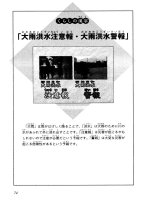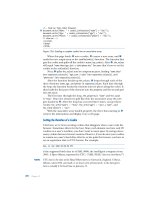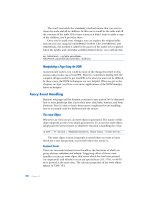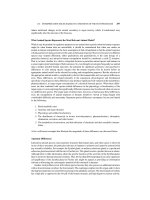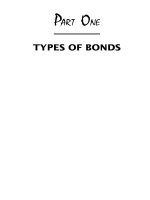Getting started in bonds 2nd edition phần 6 ppt
Bạn đang xem bản rút gọn của tài liệu. Xem và tải ngay bản đầy đủ của tài liệu tại đây (277.25 KB, 31 trang )
32/32 = 1 point
100 points = par
If a bond’s price goes from 100 to 101
1
/
2
, the bond is
said to have traded up one and a half points. Here’s a trick
to help remember this point is a percentage point (1% or
.01) of the face value. Now, look at the last sentence ex-
pressed as an equation:
1 point = 1% of the bond’s face value
There, that should be clearer. If not, here’s an example:
Bond A
Calculate the value of a point:
1 point = 1% of the face value
Face value: $25,000
1 point = 1% ×$25,000
= .01 ×$25,000
= $250
Now that you’ve calculated the value of a point, you
can figure the dollar value of the bond at different prices.
Calculate the value the bond priced at 103:
Value at 103 = Face value + 3 points
= $25,000 + (3 ×$250)
= $25,000 + $750
= $25,750
Calculate the value the bond priced at 90:
Value at 90 = Face value – 10 points
= $25,000 – (10 ×$250)
= $25,000 – $2,500
= $22,500
Price
139
Here are two final items to remember when trying to
convert points into dollars.
The first is to remember that the dollar value of a
point is different for bonds with different face values. For
example, say two different bonds both fall 3 points. One
bond ($10,000 face value) loses $300 while the other
($1000 face value) has just a $30 loss.
The second item is don’t assume that a point always
equals 1%, because this is true only if you start at par. A
decline in price from 89 to 86 is 3 points but it is a drop of
3.37%. An increase from 104 to 107 is 3 points but is a
rise of 2.88%. A drop in price from 85 to 70 is 15 points
but is a drop of 17.6%. And so on
Something Less than the Point
When the price of a bond includes a fraction of a point, it
is broken down into 1/32 increments; 2/32 is referred to
as 1/16, 4/32 as 1/8, 8/32 as
1
/
4
, and 16/32 as
1
/
2
.
In bond pricing notations, a price of 101-02 is
101
2
/
32
(i.e., 101
1
/
16
, not 101
2
/
100
or 101.02). It is not the
decimal system. In the price 101-02, the 101 part (i.e., the
whole number) is called the handle in trading jargon.
When institutional traders are trading, the handle is often
known and not mentioned. For example, “We’ll bid 02 for
the bonds.”
A bond priced at 99
1
/
8
whose price rises
3
/
4
of a point
would then be worth 99
7
/
8
.
99
1
/
8
+
3
/
4
= 99
4
/
32
+
24
/
32
= 99
28
/
32
= 99
7
/
8
WHAT IS IT WORTH TO YOU?
140
To calculate percentage change, remember “ebb”:
ending value minus beginning value divided by
beginning value. For example:
(Ending – Beginning) ÷ Beginning = % change
(86 – 89) ÷ 89 = – 3.37%
handle
trader lingo for
the part of the
bond’s price that
is a whole
number. When a
bond’s price is
98
1
/
4
, the handle
is 98.
The dollar value of each 1/32 depends on the origi-
nal face value of the bond.
Bond A
Face value: $25,000
1 point = $25,000 ×.01 = $250
Bond B
Face value: $1,000
1 point = $1,000 ×.01 = $10
To calculate the corresponding value of a 32nd, di-
vide the point’s dollar value by 32:
Bond A
$250 ÷ 32 = $7.8125
Bond B
$10 ÷ 32 = $.3125
Once in a great while you will hear someone speak
of a plus (symbolized:
+
) as in 98
1
/
8
+
(i.e., “98 and an
eighth plus”).
A plus equals
1
/
64
. So, 98
1
/
8
+
is just another way of
saying 98
9
/
64
.
98
1
/
8
+
1
/
64
= 98
8
/
64
+
1
/
64
= 98
9
/
64
This shorthand expression developed in institu-
tional trading where speed is often critical during fast
markets. Since institutional traders are trading in size, the
difference in the prices other traders offer them can be
quite small. It is easier for the trader to quickly compare
prices using pluses. Referring to the preceding example,
you can see how 98
1
/
8
and 98
1
/
8
+
are much easier to com-
pare at a glance than 98
1
/
8
and 98
9
/
64
.
Price
141
plus
add
1
/
64
to the
price given.
institutional
trading
sector of the
bond market
where bonds are
traded in very
large size—for
example, $1
million. The
smaller-sized
trades done by
individuals are
usually done on
retail trading
desks.
fast
markets
when prices in
the secondary
market are rising
or falling with
extreme speed.
Accrued Interest
A bond investor earns interest every day; however, it is
paid out only twice a year. Between payments interest ac-
crues to the owner. The price rises by that amount every
day and then drops by the total amount of interest when it
is paid out (Figure 10.2). This price movement is some-
times hard to distinguish due to other factors in the sec-
ondary market that also affect the bond’s price. Some of
these factors will be reviewed in Part Three.
Here is an example of this phenomenon.
Data Calculations
Bond’s face value: $1,000
Value of 1 point: $10$1,000 ×.01 = $10
Interest rate: 6%
Semiannual interest $1,000 ×.06 = $60
payment: $30 $60 ÷ 2 = $30
Interest’s daily 6 months ×30 days =
accrual: $.17 180 days
$30 ÷ 180 days = $.17
Using these numbers, let’s see in Table 10.1 how this
daily interest accrual can affect the bond’s price, assuming
an original price of 104, no market moves during the six-
month period, and that each month has 30 days. ($.17 ×
30 = $5 monthly accrual).
WHAT IS IT WORTH TO YOU?
142
FIGURE 10.2 Coupon accrual.
143
TABLE 10.1 Coupon Accrual
Last
Coupon
6 months
Payment 1 Month 2 Months 3 Months
4 Months 5 Months – 1 Day 6 Months*
Price
104 104.5 105 105.5
106 106.5 107 104
Value
$1,040 $1,045 $1,050 $1,055 $1,060
$1,065 $1,070 $1,040
*At this time $30 in interest is paid out.
When a bond is purchased in the secondary
market, the new owner pays the previous investor the
current market value of the bond plus any accrued in-
terest the previous investor has earned but not yet been
paid. In the previous example, if the bond traded the
last day of month 4, the purchaser would owe the seller
$20 per bond.
In other words, accrued interest is included in the
price because the purchaser owes the previous owner the
interest that she/he earned from the last interest pay-
ment until the trade date. Interest payments are made
twice a year: on the anniversary of the bond’s maturity
and six months before. The purchaser will then receive
the full coupon when paid by the issuer, so his or her net
income (amount received from issuer minus amount
paid to previous owner) is for only the period he or she
owned the bond.
For example, assume it’s now 2005:
Bond C: The Tree Corp. 7
1
/
4
% 8/15/15 N/C
Face value: $10,000
Trade date: 5/15/05
Settlement date: 5/18/05
Last interest payment: 2/15/05
Purchase price: 103
1
/
4
($10,325)
The new owner owes the previous owner the three
months of interest from February 15th to May 15th.
How much is that? Well, the bond pays ($10,000 ×
.0725). $725 a year in interest, in other words, ($725 ÷ 2)
or $362.50 per semiannual interest payment. Corporate
bonds use a 365-day year, so this bond accrues $1.986 in
interest a day ($725 ÷ 365). Since 92 days have transpired
from the last interest date to the trade date, the previous
owner is owed $182.71. This is added to the purchase
price: $10,325 + $182.71 for a total price owed of
$10,507.71.
WHAT IS IT WORTH TO YOU?
144
Interest earned per day: $725 ÷ 365 = $1.986
Interest owed: $1.986 ×92 = $182.71
Price: $10,325 + $182.71 = $10,507.71
Pricing Zeros
This section is going to take the same concepts we’ve just
gone over and apply them to pricing zero coupon bonds
(zeros).
Zeros are issued at a deep discount from their face
value. They don’t pay interest until maturity.
For example, if you buy a 6% zero that matures in 10
years at $10,000, the bond would be issued at roughly 55,
meaning you would pay $5,500 for it ($10,000 ×55%, or
$10,000×.55 = $5,500).
A zero with $10,000 face value:
Price Value
At issue 55 $5,500
At maturity 100 $10,000
The investor earns $4,500 in interest over the life of
the bond. This amount actually assumes a constant an-
nual reinvestment rate, and so it also includes the interest
on your interest. (See Figure 10.3.)
You now know a little known fact, that zeros are like
coupon bonds that automatically reinvest your interest for
you semiannually. The benefit is you eliminate the
coupon’s reinvestment risk and don’t have to mess with
reinvesting it yourself.
After a zero has been issued, accrued interest is in-
volved in determining its theoretical par value. Using our
previous example, let’s say the secondary market never
moves during the 10 years that the bond is outstanding.
During this time, the zero coupon bond’s par value would
rise by the same amount every day so that at the end it is
equal to the maturity’s $10,000 face value.
There are approximately 3,650 days in 10 years. (In
real life, the calculation would take into consideration
leap years.) After 3,650 days, the value of this zero would
Price
145
have risen $4,500 from the $5,500 purchase price to reach
its $10,000 face value by its maturity date.
$4,500 ÷ 3,650 days = 1.233
So, if you screen out market gyrations, the bond’s
price would have to rise by roughly $1.23 a day. This is
what is known as straight-line amortization: The original
value increases by the same increment every day, eventu-
ally reaching the face value when it matures.
As mentioned before, a zero’s face value also in-
cludes compounded interest-on-interest. The more accu-
rate measure is not a straight line but a curved one that
moves higher more quickly the closer you are to matu-
rity because the compounding effect accelerates.
WHAT IS IT WORTH TO YOU?
146
FIGURE 10.3 Zero’s payout at maturity.
straight-line
amortization
the same
increment is
added to the
price every day.
Figure 10.4 illustrates the theoretical amortization
line. Each day there is a theoretical price that falls along
this line that can be thought of as the zero’s par value. Any
market price above this line is a premium, and any price
below is a discount.
Investors must pay taxes on a zero’s accrued inter-
est. Even though zeros do not pay interest until maturity,
Price
147
The government wants you to pay taxes on a taxable
zero’s interest every year even though you don’t get
the interest until the bond matures. Every year you
take this amount of annual interest and add it onto
your cost basis. If you sell before the bond matures at
a price above this adjusted cost basis, you owe capital
gains on the difference. If you sell below this ad-
justed cost basis, you have a capital loss in the
amount of the difference. You need to calculate how
much interest accrues daily. This can be a nightmare;
it’s best to call an accountant or the IRS for guidance.
FIGURE 10.4 Zero coupon’s price accrual.
accrued
interest
bond investors
earn interest
every day, but it
is paid out only
periodically;
most pay
semiannually,
and a few pay
monthly. Accrued
interest has been
earned by the
investor but has
not yet been paid
out.
investors owe taxes every year on the interest earned but
not yet paid out. This is the amount the amortization line
has risen during the past year.
Conclusion
There have been articles written about how difficult it is
to price bonds since so few are traded on exchanges. The
fact that most bond trading goes on over-the-counter
(OTC) makes it difficult for the layperson to know where
prices are. While you may not be able to find the price of
your exact security, you may be able to find the price of a
similar security on the World Wide Web or by using an
investment firm’s software. A great source of information
and bond-related links is the Bond Market Association, at
www.investinginbonds.com.
YIELD
As is probably obvious by now, nothing is straightforward
when it comes to bonds. We’ve just discussed that a bond’s
price is measured in points. Well, just to further obfuscate
bonds’ helically entropic counterlogical labyrinth, yields
are measured in points too—basis points (bp); but basis
points are very different from price points.
When a bond’s yield moves from 5% to 6%, the yield
has increased 1%:
5% + 1% = 6%
But the percentage change is actually 20%:
5% + (5% ×20%) = 6%
When we talk about yield, the confusion arises be-
cause “up 5%” can mean up five 1% units or up a 5%
change from the first measurement. Even trying to explain
the point of confusion is confusing. Let’s see if an example
helps show how this is confusing. You can say you gained
10 pounds or you can say your weight is up 8%; your ap-
WHAT IS IT WORTH TO YOU?
148
basis
point (bp)
the smallest
measure when
discussing bond
yields; 1 basis
point equals
.01%. Traders
sometimes call
them “beeps.”
ple harvest can be up 80 bushels or up 25%; your heating
bill can be up $10 or up 5%. But, when you’re talking
about bonds, you can say the yield is up 1% or it’s up 20%
and be right both times, because the unit and the change
are both referred to as percent; confusion abounds. (See
Figure 10.5.)
In a bond trader’s hectic world being clear is cru-
cial since a misunderstanding can be costly to the tune
of hundreds of thousands of dollars, so this potential
area of confusion had to be eliminated. A term other
than percent was coined for a unit of yield. So, a bond’s
yield is measured in basis points (abbreviated “bp”).
When a bond’s yield moves from 5% to 6%, it has risen
100 basis points.
A basis point equals .01%. There are 100 basis points
in 1%. Here are some examples:
300 bp = 3%
100 bp = 1%
50 bp = .5%
1 bp = .01%
Yield
149
FIGURE 10.5 Computing change can be confusing.
Drawing by Steven Saltzgiver.
If someone tells you A-rated corporates are yielding
200 basis points more than A-rated munis and you know
A-rated munis are yielding 7%, you can then figure out
that A-rated corporates are yielding 9%.
200 bp = 2%
7% + 2% = 9%
Here’s another example: If a bond yielding 7.25%
gained 7 basis points, its yield would rise by .07% to
7.32%. Another time you could hear basis points being
used is in a sentence like, “The Fed’s tight monetary
policy could lower market interest rates 50 to 75 basis
points.”
Figuring Value
When you’re trying to decide whether one bond is a bet-
ter value than another bond, you do so by comparing
their yields, not by comparing their prices. That means
that understanding what different yield measures tell you
is of premier importance. Each type of yield measure is
unique and provides you with different information. Not
knowing the difference between them is one of the most
common and most dangerous information gaps bond in-
vestors share.
It is dangerous because investment professionals
who are either unethical or uninformed can tell you the
bond’s highest yield instead of the most accurate. By most
accurate, I mean the yield you are most likely to actually
earn. You can check to make sure you were told the right
yield by looking at your trade confirm. The Securities and
Exchange Commission (SEC) requires that the yield dis-
closed on the confirm be the most conservative and the
most likely to be received. If you don’t like what you see,
call back and cancel the trade. You don’t “own” the bonds
until the settlement date even though you earn interest
from the trade date.
To avoid any misunderstanding or miscommunica-
WHAT IS IT WORTH TO YOU?
150
confirm
short for “trade
confirmation,”
this lists all the
particulars of the
trade.
tion, let’s take a little time now to become acquainted with
the various yield types:
✔ Coupon yield.
✔ Current yield.
✔ Yield-to-maturity (YTM).
✔ Yield-to-call (YTC).
✔ Yield-to-worst (YTW).
Coupon Yield. The coupon yield tells you how many
dollars you’ll receive while the other yields tell you what
your return on investment will be. The only time the
coupon yield is your return on investment is if you pay
par for the bond.
The term “coupon yield” originates from the not
too distant past when an investor who bought a bond ac-
tually received a printed certificate with coupons at-
tached. When it came time for an interest payment, the
bondholder would clip the coupon and redeem it for the
cash due.
You can use the coupon yield to calculate the an-
nual income and the interest payments you’ll receive.
For example, a bond that has a $10,000 face value and
7% coupon yield would pay $700 a year: 7% of $10,000
is $700.
$10,000×.07 = $700
Yield
151
The confirm is sent after a bond trade is executed
but before the settlement date to the investor with a
duplicate sent to his/her investment professional.
The confirm details all of the trade particulars: secu-
rity description, price, accrued interest, trade date,
settlement date, dollars owed or to be received. The
investor checks the details to make sure they are
correct. If they are correct and the investor is buy-
ing, the investor sends in a check.
coupon
yield
the interest the
issuer has
promised to pay,
an annual
percentage of the
face value.
Since the annual income is paid in two semiannual
installments, the interest payments can be found by divid-
ing the annual income in two.
$700 ÷ 2 = $350
Current Yield. When you go to the deli counter and
ask for two pounds of salami, the white-clad butcher
slices off a pile of meat and hands you a neatly wrapped
package. The current yield is analogous to the two
pounds you asked for; it is not the 2.17 pounds you
actually get. It is only a rough estimate of what you
received.
Think of the current yield as a thumbnail sketch of
your future return on investment. It’s useful for a quick
return estimate when you’re paying something other
than par for the bond. However, when you’re making a
comparison and investment choice between different
bonds, you should use one of the other types of yield
we’ll discuss.
Current yield is arrived at by taking the bond’s an-
nual income and dividing it by the bond’s current price
(value). For example, look at the same bond’s current re-
turn at different price levels:
Face value: $1,000
Coupon: 10%
Annual income: $1,000 ×.10 = $100
Price #1: 97
Value: $1,000 ×.97 = $970
Current yield: $100 ÷ $970 = .103 or 10.3%
Price #2: 104
Value: $1,000 ×1.04 = $1,040
Current yield: $100 ÷ $1,040 = .0962 or 9.62%
WHAT IS IT WORTH TO YOU?
152
current
yield
to calculate,
divide the bond’s
annual dollar
interest by the
current market
price.
Price #3: 100
Value: $1,000 ×1 = $1,000
Current yield: $100 ÷ $1,000 = .10 or 10%
Note that when the price is par, the current yield
equals the coupon yield.
While current yield is fine for a quick yield calcula-
tion, it misses some important nuances that are captured
in the yield-to-maturity measure.
Yield-to-Maturity. The previous two yields are simple
yields. They do not take into account that you can rein-
vest your income and the significant effect compounding
coupons can have on you returns. When you own a
bond with a larger coupon, you will receive your money
sooner. This means you can reinvest this money and
earn more money for a longer period of time. Yield-to-
maturity (YTM) helps you account for this advantage. It
allows you to accurately compare bonds with different
coupons and maturities.
YTM does this by calculating what your return
would be if you were able to reinvest your income at a rate
equal to the YTM.
Luckily, logarithmic calculators can calculate a
bond’s YTM for you, because you don’t want to do it by
hand. That would take you what my grandmother called
“a month of Sundays.” For the masochists among you, the
formula is in the accompanying sidebar.
Assuming the bond was priced at par when it was is-
sued, when the bond is priced at 100, the coupon rate
equals the current yield and it will also equal the yield-to-
maturity.
At 100:
Coupon = Current yield = YTM
When a bond trades to a premium (price > 100):
Coupon > Current yield > YTM
Yield
153
For example:
UST 7
7
/
8
% Feb 21
(i.e., U.S. Treasury, 7
7
/
8
% coupon, due February
2021)
Price spread: 126-02 / 126-08
Ask yield: 5.78%
7
7
/
8
% > 6.2% > 5.78%
Coupon > Current yield > YTM
WHAT IS IT WORTH TO YOU?
154
The general formula* for the yield-to-maturity for a
bond paying interest semiannually is:
where
P = price of bond
n = number of years to maturity
C = annual dollar coupon interest
r = yield-to-maturity
R = redemption value of bond at maturity
t = 1
*Source: The Handbook of Fixed Income Securities, 2d edition,
edited by Frank J. Fabozzi and Irving M. Pollack, Homewood, IL:
Dow Jones-Irwin, 1987, p. 64.
You may ask, how do you find an answer when
the answer is in the formula? You have to keep try-
ing numbers until you narrow it down to the correct
answer. People used to use the bond yield table to
look up YTM approximations. However, with the
advent of financial calculators and financial software
that can give you the exact answer in nanoseconds,
you can’t even find a bond yield table anymore, be-
cause no one uses it.
P
C
r
R
r
t
t
n
n
=
+
+
+
=
∑
/2
1
2
1
2
1
2
2
When a bond trades to a discount (price < 100):
Coupon < Current yield < YTM
For example:
FNMA 6.20% 11/03
Price spread: 98-25 / 98-31
Ask yield: 6.43%
Coupon < Current yield < YTM
6.2% < 6.3% < 6.43%
Yield-to-Call. As we have seen, some bonds can be
retired before their maturity date. These are known as
callable bonds. The issuer can call the bonds in, but
only after specific dates at set prices. Callable bonds
are usually issued by municipalities or corporations.
There are still a few callable U.S. Treasury securities
outstanding.
For example:
XOM 7
5
/
8
2/33 – 03 @ 102, 05 @ 100
This is an issue of Exxon Corp. with a 7
5
/
8
% coupon
maturing on February 15, 2033; the first possible call date
is on February 15, 2003, at a price of 102 until February
15, 2005, when it can be called at 100.
When a bond is likely to be called, you would want
to know what the yield-to-call (YTC) is, not the YTM. A
bond is most likely to be called if interest rates drop and
the issuer wants to refinance its old higher-cost debt. This
means that premium bonds are more likely to be trading
at their YTC because the probability they will be called by
the issuer is higher.
Yield-to-Worst. So, if a bond is callable, how do you
know whether to use the YTM or one of the YTCs
when comparing bonds? The rule here is: Always use
Yield
155
yield-to-
call (YTC)
estimated yield
investor will
receive if the
bond is called
before maturity
by the issuer.
trading at
the yield used to
price the bond.
The secondary
market feels the
bond should
offer the investor
this yield; thus,
the bond’s price
adjusts so the
investor
receiving this
coupon will earn
this yield.
the lowest yield. This yield is known as the yield-to-
worst (YTW).
For example:
BENCO 5
3
/
4
8/15/09-04
Maturity Yield
8/15/09 5.63%
Call Dates Yield
8/15/04 5.60%
8/15/07 5.57%
For this bond, the second call date results in the
YTW. Therefore, this bond should be sold at a 5.57% YTW.
Most investment professionals have a Monroe calcu-
lator or software on their computer that calculates the
yield-to-worst, accrued interest, and so on. All you have
to do is ask. If they can’t give you these yields, you may
want to suggest they read this book.
You may have noticed in the preceding example that
as the price goes up, the yield goes down. This leads us to
our next discussion.
WHAT IS IT WORTH TO YOU?
156
If a bond is callable, trading at a premium, and the
yield-to-call (YTC) is lower than the yield to matu-
rity (YTM), you should use the YTC in order to ap-
propriately compare it with other bonds. In this
case, the YTC is the yield that the market deems as
the most likely to be realized because it looks like
the bond is likely to be called. So this is the yield,
not the yield-to-maturity, that the market will use to
price the bond. The price will adjust in the market
so that the bond’s YTC is equal to similar bonds and
fits into the spectrum of other bond yields.
PRICE IS INVERSELY RELATED TO YIELD
When I first started working at a large mutual fund
company, I had a headset planted on my head and was
answering brokers’ inquiries. The company was known
for its bond funds; so, since my previous experience in-
cluded assisting two stock jocks and peddling copier
equipment, I was desperately trying to sharpen my fixed
income acumen before anyone discovered I had no idea
what I was talking about.
I remember the guy in the cubical opposite patiently
explaining to me how a bond’s price is inversely related to
its yield. To my mind, their moving in opposite directions
seemed counterintuitive. I pretended to understand, po-
litely giving him the old smile and nod but secretly won-
dering if he really knew what he was talking about—could
bonds actually be so convoluted?
That night I kept thinking about what he’d said. The
next day I asked him for clarification and hoped I was able
to disguise the fact I had no idea what he’d been talking
about the day before. He gallantly tried again. This time I
glimpsed the concept a couple of times but the essential
why still eluded me. Then on the third day my coworker’s
diligent labor paid off, and the heavy cerebral cloud cover
parted as rays of enlightenment shone down—the Aha!
experience.
Hopefully, it won’t take you as long as it did me, but
if it does, stick with it because everything else hinges on
springing open this Pandora’s box. Since different strokes
work for different folks, there are a few different explana-
tions to follow.
Take 1
The classic analogy for demonstrating the relationship be-
tween price and yield is a seesaw (see Figure 10.6). How-
ever, while this may be a useful image to help you
remember the relationship, it does nothing in the way of
explaining why. If you’re like me (I’m like an interest rate
atheist), you need to understand why before you’ll accept
Price Is Inversely Related to Yield
157
anything. However, if you don’t care why, skip to the next
chapter, “Riding the Curve.”
Take 2
An analogy illustrating the price/yield relationship would
be: buying oranges to make orange juice. You buy 10 fresh
oranges for $2 to make 1 quart of orange juice.
However, after you buy your oranges a new ship-
ment comes in. These oranges produce twice as much
juice as yours: 10 new oranges make 2 quarts of juice.
You want to sell your oranges for $2, but the buyers at
the fruit market aren’t interested in them. The new or-
anges are much more attractive to potential buyers be-
cause their juice yield is so much higher than yours. (See
Figure 10.7.)
In order to attract buyers, you have to lower the
price of your 10 oranges to $1. At this price, buyers can
buy 20 of your less desirable oranges, which would bring
their juice yield up. Since the orange investors’ juice yield
will be the same for the same cost—$2 for 2 quarts—they
won’t care which batch of oranges they buy.
WHAT IS IT WORTH TO YOU?
158
FIGURE 10.6 Price moves opposite yield.
Drawing by Steven Saltzgiver.
Take 3
As the name “fixed income” implies, most bonds have a
fixed interest (coupon) rate that doesn’t change. The fact
that the coupon doesn’t change while interest rates are
constantly changing in the secondary market is what
causes bond prices to move in the opposite direction from
current interest rates. As interest rates go up, bond prices
go down, and vice versa.
Think of it this way: Bond A comes to market. It’s a
popular offering, and investors snap it up.
Sometime later interest rates rise; Bond B comes to
market and its coupon is higher than Bond A’s. Older bonds
with lower coupons are less attractive. New investors would
rather buy Bond B than Bond A. Bond A’ s price has to fall to
in order to entice investors. (See Figure 10.8.)
Since the market is efficient, Bond A’s price should
fall until the demand for it (an older, lower-coupon bond)
is the same as the demand for the new, higher-yielding
bonds. Investors will be indifferent as to which bond they
own when the YTM is the same for both bonds.
Price Is Inversely Related to Yield
159
FIGURE 10.7 Price changes with moves in current market
yield.
Drawing by Steven Saltzgiver.
Conversely, when interest rates fall, everyone wants
older bonds instead of the new issue. The new Bond C is
less attractive because it has a lower coupon. So, investors
bid up the prices on older bonds in their hunt for higher
interest rates. As older bonds’ prices rise, their effective
yields drop. The prices will continue to rise until Bond
A’ s and Bond B’s YTMs fall to Bond C’s YTM.
Take 4
Let’s look at a bond example with some numbers at-
tached. When bonds first come to the market, they are
sold for par (par = 100). Say a company issues a bond in
January with a 10% coupon maturing in 5 years.
Bond A
Maturity: January
Coupon: 10%
Price: 100
YTM: 10%
WHAT IS IT WORTH TO YOU?
160
FIGURE 10.8 Price changes as yield adjusts to current
market yield.
Drawing by Steven Saltzgiver.
The company issues additional 5-year bonds in April
when interest rates have risen to 12%. If any of the Janu-
ary investors now wish to sell, they will have to discount
the price of their bonds since investors would rather be
paid April’s 12% than January’s 10%.
But how far will they have to lower the price? Well,
the price will fall until investors can earn the same
amount of money regardless of which bond they buy. In
other words, the price on Bond A will drop until its YTM
equals Bond B’s YTM.
Bond A Bond B
Maturity: January Maturity: April
Coupon: 10% Coupon: 12%
Price: 97 Price: 100
YTM: 12% YTM: 12%
Now let’s say soon thereafter current interest rates
move back to 10%. Each bond’s price would rise to the
point where its YTM equals 10%.
Bond A Bond B
Maturity: January Maturity: April
Coupon: 10% Coupon: 12%
Price: 100 Price: 103
YTM: 10% YTM: 10%
As you can see, bonds that have already been issued
and are trading in the secondary market constantly re-
adjust their market price in response to current interest rate
moves. Since they can’t change their coupons, they are al-
ways adjusting their prices so their YTMs are in line with
current interest rates; that way buyers will still be interested.
As interest rates rise, bond prices in the secondary
market fall so that their yields will move higher to line up
with current interest rates and buyers will get a fair yield.
As interest rates fall, bond prices in the secondary
market rise so that their yields will move lower to line up
with current interest rates, and sellers will get a fair price
for their bonds.
Price Is Inversely Related to Yield
161
163
11
Riding the Curve
THE YIELD CURVE
“Reading” the yield curve will be one of your greatest aids
when you’re deciphering the fixed income market’s future
direction and formulating your investment strategy. It
gives you insight into market sentiment and expectations.
You can also identify value along the curve.
When you read the yield curve through a looking
glass oriented toward the past, you can identify oddball
behavior that’s due for some corrective discipline. Our ef-
ficient markets will quickly apply a firm hand to any un-
warranted aberration and will bring prices and yields back
into a more normal pattern.
Catch the Curve: What Is a Yield Curve?
The yield curve plots the current yield-to-maturity for
each maturity from three months out to 30 years. (See
Figure 11.1.) The graph’s “y” (i.e., vertical) axis plots the
yield; the “x” (i.e., horizontal) axis marks the maturities.
The yield curve in Figure 11.2 is said to be posi-
tively sloped. This means the short-maturity end of the
curve (3 months to 2 years) is yielding less than the
long-maturity end (10 to 30 years). It is also a steep
Chapter


